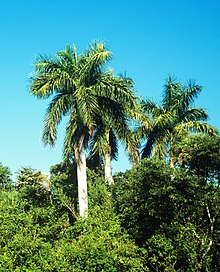Unofficial national symbols of Cuba
The unofficial national symbols of Cuba are those symbols and iconographies widely used as a representation of Cuban identity. Although they have not been officially adopted, they are popular and represent the history, nature and idiosyncrasies of Cuba and Cubans. These symbols are the butterfly flower, the royal palm, the tocororo, and the yara flag, although there are also others.
National flower
Cuba's national flower is the butterfly, whose scientific name is Hedychium coronarium J.Koenig, from the zingiberaceae (apocynaceous) family. It is not native to Cuba but to Asia, but it has adapted wonderfully to Cuban soil. It was in 1936 that the botanists of the Garden of Peace in Argentina asked their Cuban counterparts to determine what the national flower could be. On October 13 of that same year, the butterfly was chosen because its whiteness represents the purity of the independence ideals and is a symbol of peace. In addition, white is an element present in the stripes of the national banner. The shape of its flowers, attached to the central stem, symbolize the union of Cubans. It is also a paradigm of the grace and slenderness of the Cuban woman. According to oral tradition, it is said that during the independence wars, messages for the liberating army were hidden inside these flowers, attached to veils and thugs.
National Tree
When we talk about the National Tree, we refer to the big tree that appeared on October 6, 1953, the royal palm, whose scientific name is Roystonea regia O.F.Cook. It is recognized by Cubans as the queen of the fields due to the majesty of its structure, its peculiar size, the usefulness it provides and for also being the most numerous of the trees on the Island. It belongs to the palmaceae, it is a tall, erect tree that generally reaches between forty and fifty feet in height, crowned by a beautiful tuft of pinnatisect leaves, capable of arousing such admiration that many poets and musicians have sung to its elegance. Its fruits bloom almost all year round and since time immemorial it was used, first by the aborigines and later by Cuban peasants, to satisfy some of their most vital needs, from food for farm animals to wood for construction. of houses and leaves to cover their roofs. Its gallant presence on the National Shield represents the freedom and independence of the young Cuban republic, a symbol of the freshness and fertility of its privileged soil. It is not exclusive to Cuba, it is also found in Venezuela.
National Bird
The tocororo, whose scientific name is Priotelus temnurus of the order Trogoniformes and belonging to the family Trogonidae. Called by the Cuban origins as "guatini", a name that continues to be used in some of the eastern provinces. It lives in wooded areas of the country, preferably in the mountains. It is considered the national bird for two reasons: its splendid plumage of bright colors and its resistance to captivity, since it dies when held captive. Considered the most beautiful bird in Cuba, part of its green plumage recalls the fields, its chest with white feathers, its belly with red plumage and the blue feathers on its head complete the clear symbolism of the national banner.
Flag of La Demajagua
Also known as the «Yara flag» or «The flag of October 10», it was created by Carlos Manuel de Céspedes, the Father of the Cuban Homeland, and made by Candelaria Acosta "Ambula". According to the son of Céspedes, his father would have been inspired by the Chilean flag (installed on October 18, 1817) for its creation: «he imagined a new flag, which would have the same colors and shape as the Carreras flag [ sic] and O'Higgins differs from it in the disposition of those».
This flag has presided since 1868, and continues to preside, together with the national ensign, all sessions of the Cuban parliament.
Others
National poet
Several poets have received, at different times, the title of National Poet of Cuba, including José María Heredia (1803-1839), whom José Martí himself praised for his poetry, of profound patriotic content, among which his Ode to Niagara stands out especially with the description of the "palms that in my country sway from the wind to a smile", Julián del Casal, the Cuban poet who died laughing (1863-1893), Agustín Acosta (1886-1979) and finally Nicolás Guillén (1902-1989), known especially for his Motivos del Son and his black poetry such as contribution to the spectrum of the components of the Cuban nation and nationality, especially for the musicality of his verses.
National sport
The national sport of Cuba is undoubtedly the pelota or baseball. It arose in the United States and began to be practiced in Cuba at the end of the 19th century.
National Dance
The danzón was created in Matanzas in 1878. It is currently one of the most used dances when representing the country in its typical dances.
Contenido relacionado
Shaft grave tradition
Universal history
Appeasement policy



